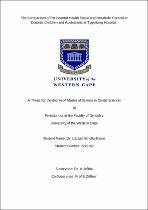| dc.contributor.advisor | Schneider, Helen | |
| dc.contributor.author | Alexander, Henry George | |
| dc.date.accessioned | 2017-07-19T13:58:00Z | |
| dc.date.available | 2017-07-19T13:58:00Z | |
| dc.date.issued | 2016 | |
| dc.identifier.uri | http://hdl.handle.net/11394/5498 | |
| dc.description | Magister Public Health - MPH | en_US |
| dc.description.abstract | BACKGROUND AND RATIONALE: The Cape Town Metro District Health Service (MDHS) has introduced a Diabetic RetinopathyScreening (DRS) programme incorporating retinal fundal photography in diabetic services at primary health care (PHC) facilities. Hitherto, coverage of the DRS programme has been less than optimal in part due to volumes of diabetic patients attending PHC facilities. The aim of this study was to identify possible sub-groups of patients, attending the Cape Town DRS Programme, who are at most risk of diabetic retinopathy and might be prioritised for early diabetic retinopathy detection and subsequent sight-saving treatment. METHODOLOGY: A case-control study of risk factors for treatment-requiring diabetic retinopathy was conducted. This research sampled participants from the DRS programme provided by the MDHS eye care team to Type II diabetics attending public PHC facilities within the Klipfontein and Mitchells Plain Sub-Districts. Based on fundal images, cases were selected as those requiring ophthalmological treatment; and controls (three matched per case by area of residence) as those judged as not requiring ophthalmological treatment for diabetic retinopathy. Data on possible risk factors (clinical, laboratory) were extracted from the patients' folders.
RESULT: The study included 453 participants, of whom 113 (24.9%) were cases and 340 (75.1%) were controls. Three factors were significantly associated with treatment-requiring diabetic retinopathy on multivariate analysis: Insulin dependency (OR of 2.96, 95% CI: 1.75 – 5.00); duration of diabetes of more than 10 years (OR of 3.44, 95% CI: 2.06 – 5.74) and sustained hyperglycaemia over the past six months (OR of 3.73, 95% CI: 1.69 – 8.22). A screening algorithm combining these criteria had a sensitivity of 61.2% (95% CI: 51.9 – 70.5).
CONCLUSION: The findings indicate that a sub-set of patients attending the DRS programme in the Klipfontein and Mitchells Plain Sub-Districts have a greater likelihood of presenting with treatment-requiring diabetic retinopathy. Further research is required to develop a tool that is sufficiently sensitive to safely prioritise patients for fundal screening. | en_US |
| dc.description.sponsorship | National Research Foundation (NRF) | en_US |
| dc.language.iso | en | en_US |
| dc.publisher | University of the Western Cape | en_US |
| dc.subject | Diabetic retinopathy screening | en_US |
| dc.subject | Diabetic retinopathy | en_US |
| dc.subject | Blindness prevention | en_US |
| dc.subject | Diabetes Mellitus | en_US |
| dc.subject | Primary health care | en_US |
| dc.subject | Cape Town (South Africa) | en_US |
| dc.title | Factors associated with diabetic retinopathy requiring treatment on fundal photography in participants of the Cape Town diabetic retinopathy screening programme | en_US |
| dc.rights.holder | University of the Western Cape | en_US |




